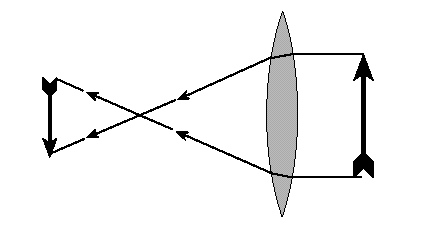Cylindrical cereal box
Tracing paper
Rubber band
Candle
Sharp knife
Pin
Aluminum foil
Cellophane tape
Double convex lens (magnifying
glass)
Dark room
Procedure:
1. Using the knife, cut a one centimeter square hole in the center of the bottom of the cereal box.
2. Cover the hole with a small piece of aluminum foil and tape in place. Poke the center of the foil with the pin to make a hole directly over the hole made in step 1.
3. Cover the open end of the box with tracing paper and fasten with a rubber band.
4. Light the candle and darken the room.
5. Aim the pinhole viewer so that the pinhole is pointed at the candle. Observe the image on the tracing paper.
6. Compare the image produced by the pinhole viewer with the image seen through a double convex lens.
Discussion:
Convex lenses invert images. Light rays converge behind these lenses and cross at the focal point. At that point, the image

becomes inverted. (See diagram on next page.) With the pinhole viewer, the change takes place at the pinhole.
Astronomical telescopes produce images like those of the pinhole viewer. Because the big lens or mirror of astronomical telescopes are large, a great amount of light is focused on the detector, producing a much brighter image than the pinhole camera. Although additional lenses or mirrors can be used to "right" the image, astronomers prefer not to use them. Each added lens or mirror removes a small amount of light. Astronomers want their images as bright as possible and do not mind if the images of stars and planets are inverted. Since most large astronomical telescopes use photographic film or CCDs as detectors, righting the image, if necessary, is merely a matter of inverting
